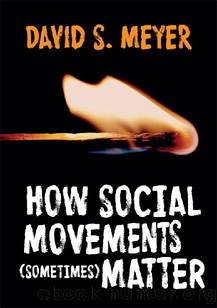How Social Movements (Sometimes) Matter by David S. Meyer

Author:David S. Meyer [Meyer, David S.]
Language: eng
Format: epub
Publisher: Wiley
Published: 2021-05-28T00:00:00+00:00
The Politics of Nuclear Power
The issues attendant to safe and sustainable energy production are more difficult and less adaptable to citizen concerns, and debates about nuclear energy have periodically emerged strongly and controversially across most Western democracies over the past half-century. Opposition to the growth of nuclear power developed along several distinct, but related lines of argument. First, nuclear power was far more expensive than existing sources of power, including both fossil fuels and alternative energy. Second, the production of fissionable material associated with nuclear power evoked connections to nuclear weaponry, and represented a threat to peace. Third, nuclear power plants, for reasons of economy and practicality, were frequently sited near bodies of water, commandeering large tracts of very attractive land. Fourth, the event of a nuclear accident could conceivably create massive environmental and health damage to surrounding areas. Reactor disasters at Chernobyl in 1986 and Fukushima in 2011 would give substance and image to such fears, spoiling farmland and spurring cancer clusters. Fifth, even the âsafeâ operation of nuclear plants, through the emission of radiation and the problem of storing nuclear waste, could create additional environmental, health, and security risks long into the future. Opponents of nuclear weapons advanced environmental, health, safety, and energy arguments in different mixes, depending upon the historical moment and the nature of the groups most committed to the campaigns. And they affected the broad range of social movement strategies for influence, ranging from civil disobedience at the sites of proposed nuclear plants to large demonstrations at those plants or national capitals, to testimony in public hearings to electoral campaigns.
Over the long haul, the most successful antinuclear campaign developed over decades in Germany. Antinuclear protests initially linked local residents in a wine-growing corner of Germany with student activists who mounted a series of demonstrations and occupation of a proposed plant in Wyhl in 1975. (At least some of those engaged were aware of a kin effort in the United States focused on a proposed plant at Seabrook, New Hampshire.) Protests spread to other potential nuclear sites, with different mixes of the same basic coalition: environmentalists and local residents. The Wyhl plant was never built, and the site ultimately became a nature preserve, but nuclear plants were established elsewhere in Germany.
The strong antinuclear movement, however, ensured that the process of building nuclear plants in Germany was more cumbersome and expensive than in other wealthy industrialized countries, and thus, less attractive to business and government. Due to the difficulty and expense of building plants there, nuclear power never comprised more than 20 percent of the power used in Germany.12 In contrast, early in the twenty-first century, nuclear power generated 30â40 percent of power in Japan, about half of the power in Belgium, and upwards of 70 percent of the electricity in France. Activistsâ initial successes in Germany were not in stopping the development of nuclear power, but in constraining it.
Outside events, particularly reactor accidents in other countries, aided the development of the movement and its ultimate influence.
Download
This site does not store any files on its server. We only index and link to content provided by other sites. Please contact the content providers to delete copyright contents if any and email us, we'll remove relevant links or contents immediately.
| Africa | Americas |
| Arctic & Antarctica | Asia |
| Australia & Oceania | Europe |
| Middle East | Russia |
| United States | World |
| Ancient Civilizations | Military |
| Historical Study & Educational Resources |
Never by Ken Follett(2873)
The Man Who Died Twice by Richard Osman(2290)
Machine Learning at Scale with H2O by Gregory Keys | David Whiting(2267)
Fairy Tale by Stephen King(2058)
Will by Will Smith(2033)
Rationality by Steven Pinker(1761)
The Dawn of Everything: A New History of Humanity by David Graeber & David Wengrow(1564)
The Dark Hours by Michael Connelly(1562)
Principles for Dealing With the Changing World Order: Why Nations Succeed and Fail by Ray Dalio(1368)
Friends, Lovers, and the Big Terrible Thing by Matthew Perry(1324)
A Short History of War by Jeremy Black(1295)
HBR's 10 Must Reads 2022 by Harvard Business Review(1251)
Go Tell the Bees That I Am Gone by Diana Gabaldon(1231)
Can't Hurt Me: Master Your Mind and Defy the Odds - Clean Edition by David Goggins(1223)
515945210 by Unknown(1205)
Fear No Evil by James Patterson(1106)
443319537 by Unknown(1069)
Works by Richard Wright(1017)
Going There by Katie Couric(989)
